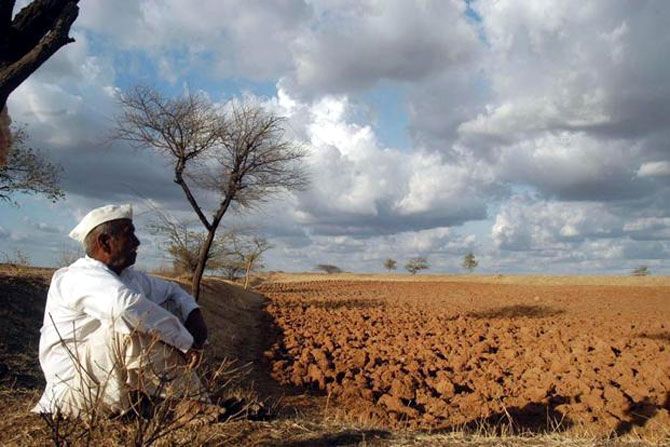The government is doing things in agriculture that count for little, says Shreekant Sambrani.

Roughly a third of the way through his Budget speech three weeks ago, the finance minister paused for dramatic effect before presenting the 10 thrust areas of the Budget.
Agriculture, rural development and youth occupied the top three places.
Arun Jaitley claimed that he had made substantial increases in allocation to these and proceeded to announce a raft of schemes: Soil health cards, irrigation project corpus, crop insurance, electronic national marketing platform, more rural works, especially farm ponds, under the Mahatma Gandhi National Rural Employment Guarantee Scheme (MGNREGS), skilling and vocational training, among others.
I have with me a stack of field surveys and reports, all done in the last 18 months and all over the country, concerning these critical issues. Admittedly, they do not add up to what is now called a robust data base, but they are not mere anecdotal evidence either.
Their summaries are eloquent, at times poignant, postcards from their respective interlocutors.
The first one is from Jankalyanpur in the country’s most important parliamentary constituency, Varanasi. The name is fictitious, but all the details are authentic.
This village, 20 km from the holy city, could not get more representative of the 600,000 such habitats in India in terms of population, area, resource endowment and facilities. It cultivates its lands and manages its cattle much the same way as practised historically: Without any significant inputs.
The main field crop and milk yields are below average. While the village is not abysmally poor as measured against accepted government norms, it just barely ekes out a living. For three-fifths of the families, that does not meet their living needs.
There are clear indications that the village has given up on agriculture and practices it simply because there is nothing else that can be done with the land.
It is not alone in such resignation. National Sample Survey findings from states, including as different ones as Punjab and Kerala, show that as many as 40 per cent of the landowners would give up farming if they could. And for good reasons.
Surveys of drought-distressed farmers in Andhra Pradesh, Maharashtra, Odisha and Telangana, reported farm incomes which left little or no savings at all, if not actual deficits.
Farmers everywhere were well aware of both production and marketing risks. They also knew that a more diversified cropping pattern caused less risk, but not all were able to practise it.
Their recourse to crop insurance was low even compared to the low national level of coverage.
The only coping mechanism, though not available to all, was wage-paid employment outside agriculture.
In Jankalyanpur, it was the dominant source of income, but the average wage per family of just over Rs 6,000 per month, was barely at the minimum wage level for year-round employment.
Farmers in all areas knew about MGNREGS, but were sceptical about whether they would get work.
The young were particularly averse to it, not in the least because of the fatigue-intensive nature of work involved and the attendant poor image of those who take it up.
Migrating to cities for work either temporarily or permanently was appealing, but not always possible.
And thereby hangs another tale.
Study after study from grass-roots levels in states as different from each other as Rajasthan and Kerala highlighted the increasing distance between education and skill enhancement programmes on the one hand and employment opportunities of the kind the youth aspire to on the other.
While the barely-literate and unskilled are the worst affected, there are now burgeoning numbers of the ITI-trained young people joining the ranks of the unemployed.
Agriculture, the default employer of the last resort, is already burdened by very substantial disguised unemployment. And has shackles of its own.
If we examine records of the past 50 years, three factors have made agriculture grow mainly.
The first is better varieties and their planting material, the one intervention that works invariably, good monsoons which are as yet not even predictable, and markets for the produce determined by consumer incomes and preferences.
High-yielding varieties of staples led to nearly trebling India’s foodgrain production since 1965.
Bt seeds similarly doubled the cotton crop in the last decade or so.
Hybrid vegetable and fruit varieties enhanced their production three-fold in the past 30 years, and increasing consumer incomes provided matching demand support.
The same is true of dairying as well.
The short point of this is that the government is doing things in agriculture that count for little.
Even debt-waiver is being mentioned again, especially in poll-bound Uttar Pradesh and Punjab. But farmers in Andhra Pradesh and Telangana, where it was recently implemented, had grave reservations about its efficacy.
Sadly, the most potent engine of agricultural growth is anathema to a section of the Sangh Parivar and it seems the government has now retreated to denial.
There was no mention of research support and the word hybrid appeared nowhere in the Budget speech.
In this era of instant communication via social media, these pieces of snailmail send messages of the greatest urgency.
The Budget has done little to mitigate the severe distress Bharat and its young are still in and the much-hyped demographic dividend is threatening to become a ticking time bomb.
Shreekant Sambrani is an economist.









